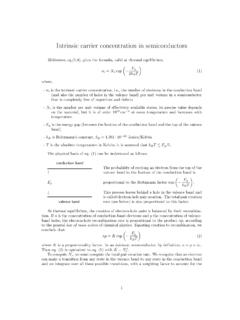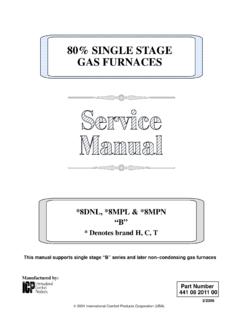Transcription of 2 0 0 5 - University of Virginia
1 CABLE TRAY MANUALB ased on the2005 National Electrical Code 2 0 0 5CT05 MANT able of ContentsPage ..2 Why Cable Tray?Safety ..3 Dependability ..4 Space Savings ..4 Cost Savings ..5-8An In-depth Look at the 2005 NEC , Section 392 Types of Cable Trays (NEC Scope)..9-11 EMI/RFI Cable Tray ..10-11 Cable Tray Materials ..12 Types of Cables Allowed in Cable Tray [ (A)]..12MI - Mineral Insulated Metal Sheathed Cable [Article 332] ..12MC - Metal Clad Cable [Article 330] ..13TC - Power and Control Tray Cable [Article 336] ..13 ITC - Instrumentation Tray Cable [Article 727] ..13 PLTC - Power Limited Tray Cable [Sections (C) and (E)] ..14 Other Types - Fire Alarm [Article 760], Multipurpose and Communications Cable [Article 800].
2 14 Single Conductor & Type MVCables [ (B)]..14 Cable Tray Use in Hazardous Locations [ (D)]..15-17 Limitations on Cable Tray Use [ ] ..18 Cable Tray Loading [ (A)]..18-20 Fiberglass Cable Tray [ (E) & (F)]..20 Discontinuous Cable Tray and Fittings [ (A)]..21-22 Covers [ (D)]..23 Barriers [ (E) & (F)]..24 Spacing of Multiple Cable Trays [ (I)]..25 Supporting Conduit from Cable Tray [ (J)]..25 Use of Cable Tray as an Equipment Grounding Conductor [ Grounding]..26-29 Fastening Cables [ (B)]..30 Cable Installation [ ]..30-32 Sizing Cable TrayMulticonductor - 2000 volts or less [ ]..32-34 Single conductor - 2000 volts or less [ ]..34-36 Type MC or MV - 2001 volts or greater [ ].
3 37 Ampacities of Cables in Cable Tray ..36-38 Cable Tray Wiring System Design and Installation Hints ..38-39 Fireproofing Tray ..40 Expansion and Contraction ..41-42 Appendix Index & Appendix Tray Installation & Specification Checklists .. Tray ManualCooper B-Line, IncINTRODUCTIONThe B-Line Cable Tray Manual was produced by B-Line's technical staff. B-Line has recognizedthe need for a complete cable tray re f e rence source for electrical engineers and designers. Thefollowing pages address the 2005 National Electric Code requirements for cable tray systemsas well as design solutions from practical experience. The information has been organized for use asa reference guide for both those unfamiliar and those experienced with cable every aspect of cable tray design and installation has been explored for the use of thereader.
4 If a topic has not been covered sufficiently to answer a specific question or if additionalinformation is desired, contact the engineering department at B-Line. We sincerely hope you willfind the B-Line Cable Tray Manual a helpful and informative addition to your technical information contained herein has been carefully checked for accuracy and is believed to becorrect and current. No warranty, either expressed or implied, is made as to either its applicabilityto, or its compatibility with, specific requirements, of this information, nor for damages consequentto its use. All design characteristics, specifications, tolerances and similar information are subject tochange without B-Line, West Monroe StreetHighland, IL 62249-0326 Tel: (618) 654-2184 Fax: (618) 654-5499 National Electrical Code and NEC are registered trademarks of theNational Fire Protection Association, Inc.
5 Quincy, MA B-Line, IncCable Tray ManualL a rge numbers of electrical engineers havelimited detail knowledge concerning wiring h e re is the tendency by engineers to avoidbecoming involved in the details of wiring systems,leaving the wiring system selection and design todesigners or contractors. Certain decisions must bemade for any wiring system installation, and thesedecisions should be made in the design andconstruction activities' chain where maximumimpact is achieved at the lowest possible design decisions to construction canresult in increased costs and wiring systemsincompatible with the owner's future in the project's design life, the costs andfeatures of various applicable wiring systems shouldbe objectively evaluated in detail.
6 Unfortunately,such evaluations are often not made because of thetime and money involved. It is important to realizethat these initial evaluations are important and willsave time and money in the long run. Theevaluation should include the safety, dependability,space and cost requirements of the project. Manyindustrial and commercial electrical wiring systemshave excessive initial capital costs, unnecessarypower outages and require excessive o re o v e r, the wiring system may not have thef e a t u res to easily accommodate system changesand expansions, or provide the maximum degree ofsafety for the personnel and the tray wiring systems are the preferred wiringsystem when they are evaluated against equivalentconduit wiring systems in terms of safety,dependability, space and cost.
7 To properly evaluatea cable tray wiring system vs. a conduit wiringsystem, an engineer must be knowledgeable of boththeir installation and the system features. Theadvantages of cable tray installations are listedbelow and explained in the following paragraphs. Safety Features Dependability Space Savings Cost Savings Design Cost Savings Material Cost Savings Installation Cost & Time Savings Maintenance SavingsCABLE TRAY SAFETY FEATURESA properly engineered and installed cable traywiring system provides some highly desirable safetyfeatures that are not obtainable with a conduit wiringsystem. Tray cables do not provide a significant path forthe transmission of corrosive, explosive, or toxicgases while conduits do.
8 There have been explosionsin industrial facilities in which the conduit systemsw e re a link in the chain of events that set up theconditions for the explosions. These explosionswould not have occurred with a cable tray wiringsystem since the explosive gas would not have beenpiped into a critical area. This can occur eventhough there are seals in the conduits. There doeshave to be some type of an equipment failure ora b n o rmal condition for the gas to get into theconduit, however this does occur. Conduit sealsprevent explosions from traveling down the conduit(pressure piling) but they do not seat tight enough toprevent moisture or gas migration until an explosionor a sudden pre s s u re increase seats them.
9 TheOctober 6, 1979 Electrical Substation Explosion atthe Cove Point, Maryland Columbia LiquefiedNatural Gas Facility is a very good example of whereexplosive gas traveled though a two hundred footlong conduit with a seal in it. The substation wasdemolished, the foreman was killed and an operatorwas badly burned. This explosion wouldn t haveo c c u r red if a cable tray wiring system had beeninstalled instead of a conduit wiring system. A NewJersey chemical plant had the instrumentation andelectrical equipment in one of its control ro o m sdestroyed in a similar type incident. In addition to explosive gases, corrosive gasesand toxic gases from chemical plant equipmentfailures can travel through the conduits to equipmentor control rooms where the plant personnel and thesensitive equipment will be exposed to the gases.
10 In facilities where cable tray may be used as theequipment grounding conductor in accordance withN E C Sections (C) & , the gro u n d i n gequipment system components lend themselves tovisual inspection as well as electrical continuity CABLE TRAY?BECAUSEACABLETRAYWIRINGSYSTEMPROVID ESSAFEANDDEPENDABLEWAYSTOSAVENOWANDLATER 3 Cable Tray ManualCooper B-Line, IncCABLE TRAY DEPENDABILITYA properly designed and installed cable traysystem with the appropriate cable types will providea wiring system of outstanding dependability for thec o n t rol, communication, data handling,instrumentation, and power systems. Thedependability of cable tray wiring systems has beenp roven by a 40 year track re c o rd of excellentperformance.




